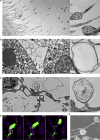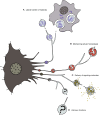Migrasomes: Biogenesis, physiological roles, and therapeutic potentials
- PMID: 39400310
- PMCID: PMC11473597
- DOI: 10.1083/jcb.202403051
Migrasomes: Biogenesis, physiological roles, and therapeutic potentials
Abstract
Migrasomes, vesicular structures discovered in migrating cells, arise from the junctions or tips of retraction fibers, and gradually grow to microscale vesicles. Migrasomes have garnered attention for their role in intercellular communication and potential therapeutic implications. This review presents an overview of recent advances in migrasome biology, covering the mechanisms of migrasome biogenesis, essential physiological roles, and their association with various diseases, alongside potential therapeutic applications. Furthermore, we share our perspectives on potential future directions in the study of migrasomes and highlight the challenges that remain in this developing area of research.
© 2024 Jiao and Yu.
Conflict of interest statement
Disclosures: The authors declare no competing interests exist.
Figures



Similar articles
-
Migrasome: a novel insight into unraveling physiological and pathological function.Mol Biol Rep. 2025 May 28;52(1):509. doi: 10.1007/s11033-025-10615-y. Mol Biol Rep. 2025. PMID: 40434508 Review.
-
Migrasomes: Critical players in intercellular nanovesicle communication.Cell Signal. 2025 Aug;132:111796. doi: 10.1016/j.cellsig.2025.111796. Epub 2025 Apr 8. Cell Signal. 2025. PMID: 40209968 Review.
-
Migrasomes: Emerging organelles for unveiling physiopathology and advancing clinical implications.Life Sci. 2024 Dec 1;358:123152. doi: 10.1016/j.lfs.2024.123152. Epub 2024 Oct 23. Life Sci. 2024. PMID: 39454990 Review.
-
Shedding light on the cell biology and diverse physiological functions of the migrasome.Cell Biosci. 2025 May 28;15(1):70. doi: 10.1186/s13578-025-01417-7. Cell Biosci. 2025. PMID: 40437622 Free PMC article. Review.
-
The roles of migrasomes in immunity, barriers, and diseases.Acta Biomater. 2024 Nov;189:88-102. doi: 10.1016/j.actbio.2024.09.013. Epub 2024 Sep 14. Acta Biomater. 2024. PMID: 39284502 Review.
Cited by
-
Migrasome-Related Genes as Potential Prognosis and Immunotherapy Response Predictors for Colorectal Cancer.Biomedicines. 2025 Mar 26;13(4):799. doi: 10.3390/biomedicines13040799. Biomedicines. 2025. PMID: 40299331 Free PMC article.
-
Extracellular vesicle heterogeneity through the lens of multiomics.Cell Rep Med. 2025 Jul 15;6(7):102161. doi: 10.1016/j.xcrm.2025.102161. Epub 2025 Jun 6. Cell Rep Med. 2025. PMID: 40482644 Free PMC article.
-
The biogenesis and biological roles of migrasomes in human diseases.Cell Death Discov. 2025 Jul 1;11(1):296. doi: 10.1038/s41420-025-02569-8. Cell Death Discov. 2025. PMID: 40595452 Free PMC article. Review.
References
Publication types
MeSH terms
Grants and funding
LinkOut - more resources
Full Text Sources

